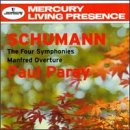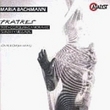| All Artists: Schumann, Paray, Dso Title: Four Symphonies Members Wishing: 2 Total Copies: 0 Label: Philips Release Date: 4/13/1999 Genres: Jazz, Classical Styles: Historical Periods, Modern, 20th, & 21st Century, Symphonies Number of Discs: 2 SwapaCD Credits: 2 UPC: 028946295526 |
Search - Schumann, Paray, Dso :: Four Symphonies
 | Schumann, Paray, Dso Four Symphonies Genres: Jazz, Classical
Paray's Schumann is characterized by swift tempos, flowing slow movements, carefully judged instrumental balances, and rhythmic precision--attributes associated with the French school of which he was an outstanding exempla... more » |
Larger Image |
CD DetailsSynopsis
Amazon.com Paray's Schumann is characterized by swift tempos, flowing slow movements, carefully judged instrumental balances, and rhythmic precision--attributes associated with the French school of which he was an outstanding exemplar. The result: lithe, energetic interpretations that avoid the muddiness that too often typifies performances of Schumann's orchestral works. The Spring Symphony benefits from this approach; the introduction, so often pompous or rushed, here manages to be both buoyant and un poco maestoso, and the rhapsodic nature of the piece comes to the fore. The Second is as attractive, its flowing Adagio a welcome relief from some recent readings that degenerate into stasis. Paray's Rhenish Symphony offers headlong forward thrust and an exuberant finale, while the Fourth builds with cumulative power. The filler, the Manfred Overture, is romanticism incarnate and Paray captures the moodiness and struggles at its core. Mercury's sound wears its age lightly (the recordings were made between 1954 and 1958) and all but the fine-sounding Fourth Symphony are in stereo. There are other fine integral sets of Schumann's symphonies available, such as the recently reissued ones by Szell and Bernstein, but Paray's is a very welcome addition to the catalogue. --Dan Davis Similarly Requested CDs
|
CD ReviewsSchumann Shines Anew in Paray Recordings I. Lipscomb | Winter Garden, FL USA | 05/26/1999 (4 out of 5 stars) "At long last, we have the four Schumann symphonies, plus Manfred Overture, released in the awesome Mercury Living Presence series. There is an aura of exuberance here not commonly found in symphony orchestra recordings. Paray leads his Detroit Symphony, well-trained in his Gallic style, in this rip-roaring set. If you doubt that Schumann lives, you owe it to yourself to listen to these enthusiastic renditions. The instrumentalists are thoroughly rehearsed and come across as very secure. The First Symphony, in particular, seems to me to be the personification of the joy of life. This is Schumann played as it should be played, and I dare anyone to call these performances routine. Mercury's sound, which was always way ahead of its time, is brilliance anew in these releases. If anything, the recordings sound newer and fresher than when they were first released on LP. Highly recommended." Paray's legacy at the forefront in Schumann Classic Music Lover | 06/02/1999 (5 out of 5 stars) "There isn't much more to add to what's already been said except to tack on a star. This is far and away the most beautiful Schumann committed to disk, the type of lost Gallic conducting art of which Paray was THE master--a unique practitioner who always gave a great performance, no matter what the material. Wilma Cozart has done an admirable job of cleaning up hiss and tubby bass from her original recording sessions in the 50s--and it seems the mono Fourth has had next to nothing done to it because the antecedent was so good. The Second had to be worked again from her binaural mixdown instead of the three channel version originally used--the 3-channel was "unavailable" according to the notes. Don't throw out any of your vinyl, especially the No. 2, since it sounds better than this reissue which lacks the wide stereo spectrum.However, these are minor caveats when we're dealing with a production of this standard. The competing Bernstein is frenetic and ragged, Szell gives us the riveting-machine approach in that irritating Severance Hall sound which had a range from "f" to "ffffff" and little else. If the Solti is back out, it is interpretatively a cipher, and Inbal, while enjoyable and clear-visioned is certainly not on the Paray level.Paray's long-awaited set is the choice from all standpoints and isn't likely to be bettered anytime soon. It's been around 40 years now and it hasn't had a serious approach yet." The original recipe Classic Music Lover | Maryland, USA | 05/06/2007 (5 out of 5 stars) "Paul Paray was one of the first conductors to go back to Schumann's own original orchestrations of these symphonies. Before that, many a conductor had tweaked and fiddled with the scores to "enhance" the melodic lines -- and also to "heavy them up" in that stereotypically Germanic manner. Perhaps it took a Gallic conductor like Paray to treat Schumann's delicate-yet-vibrant scores like a watercolor rather than an oil painting. (Paray, hearing one of Schumann's symphonies performed with a doctored score, was quoted as saying to the conductor after the concert, "Nice piece. Who wrote it?")
Paray is most effective in Nos. 1, 2 and 4. The Rhenish is not quite as special, but certainly OK. Nothing like the travesties you'll hear with Solti and the Vienna Philharmonic. Like others who have reviewed this CD, I also hear the high-pitched whine in the 4th symphony. It's not unbearable, but why couldn't the engineers have gotten rid of it?" |

 Track Listings (8) - Disc #1
Track Listings (8) - Disc #1


